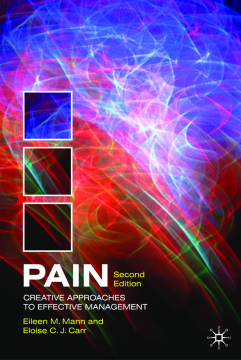
Additional Information
Book Details
Abstract
Broadened to include coverage of community settings, and updated to address changes in practice, Pain 2/e is a solid introduction to the subject. Developed from original learning tools, it is underpinned by a comprehensive pedagogic framework, and is an essential resource for all involved in pain management and assessment.
ELOISE CARR is Reader in Pain Management Research and Education, Institute of Health& Community Studies, Bournemouth University, UK.
EILEEN MANN is Nurse Consultant in Pain Management, Poole Hospital NHS Trust, and Lecturer-Practitioner, Institute of Health& Community Studies, Bournemouth University, UK.
Broadened to include coverage of community settings, and updated to address changes in practice, Pain 2/e is a solid introduction to the subject. Developed from original learning tools, it is underpinned by a comprehensive pedagogic framework, and is an essential resource for all involved in pain management and assessment.
Table of Contents
| Section Title | Page | Action | Price |
|---|---|---|---|
| Cover\r | Cover | ||
| Half-Title\r | i | ||
| Title\r | iii | ||
| Copyright\r | iv | ||
| Contents | v | ||
| List of Figures | vii | ||
| List of Tables | viii | ||
| Foreword | ix | ||
| Preface | xi | ||
| Acknowledgements | xii | ||
| Introduction | xiii | ||
| 1 The Multidimensional Nature of Pain | 1 | ||
| Background | 2 | ||
| Why has pain been so misunderstood? | 2 | ||
| An introduction to neurophysiology | 6 | ||
| Gate control theory | 10 | ||
| The psychosocial impact of pain | 16 | ||
| Neuromatrix theory | 21 | ||
| Conclusion | 23 | ||
| Multiple choice test | 24 | ||
| 2 Assessing Pain | 26 | ||
| Background | 27 | ||
| Why assess pain? | 27 | ||
| When to assess pain | 29 | ||
| How to assess pain | 29 | ||
| Nurse factors affecting the assessment of pain | 32 | ||
| Patient factors affecting the assessment of pain | 32 | ||
| Pain assessment tools | 35 | ||
| Changing practice: introducing a pain assessment tool | 50 | ||
| Conclusion | 51 | ||
| Multiple choice test | 52 | ||
| 3 Recognising the Barriers to Effective Pain Relief | 55 | ||
| Background | 56 | ||
| Healthcare professionals | 56 | ||
| Improving practice | 59 | ||
| Patient barriers to effective pain management | 63 | ||
| Organisational aspects | 67 | ||
| Barriers to effective pain management in the clinical area | 68 | ||
| Conclusion | 72 | ||
| Multiple choice test | 73 | ||
| 4 Managing Acute Pain | 76 | ||
| Background | 77 | ||
| The patients’ perspective: experiencing acute pain | 78 | ||
| Acute pain services | 80 | ||
| Pharmacological approaches to pain management | 86 | ||
| Non-pharmacological approaches to acute pain management | 103 | ||
| Conclusion | 107 | ||
| Multiple choice test | 109 | ||
| 5 Managing Chronic Pain | 112 | ||
| Background | 113 | ||
| What is chronic non-malignant or persistent pain? | 114 | ||
| The patient’s perspective: experiencing chronic pain | 117 | ||
| Managing chronic pain | 119 | ||
| Pharmacological approaches to pain management | 120 | ||
| Non-pharmacological strategies for managing chronic pain | 125 | ||
| Physical techniques for managing pain | 126 | ||
| Psychological interventions | 130 | ||
| Herbs and supplements | 133 | ||
| Other considerations when managing pain | 134 | ||
| Professional collaboration in pain management | 136 | ||
| Conclusion | 138 | ||
| Multiple choice test | 139 | ||
| 6 Managing Pain in Vulnerable Patients | 142 | ||
| Background | 143 | ||
| Defining the barriers | 145 | ||
| Pain in the older person | 146 | ||
| Pain management in the cognitively impaired older person | 149 | ||
| Learning disability and brain-injured patients | 155 | ||
| Neonates and preverbal children | 156 | ||
| Ethnic minorities | 164 | ||
| Conclusion | 167 | ||
| Multiple choice test | 168 | ||
| 7 Nursing Patients with Challenging Pain | 171 | ||
| Background | 172 | ||
| Pain following a serious burn | 173 | ||
| Pain in the patient with a spinal injury | 177 | ||
| Pain in patients with sickle-cell disease | 180 | ||
| Mood disorder and pain | 183 | ||
| Substance misuse | 187 | ||
| Intractable pain and secondary gain/loss | 192 | ||
| Conclusion | 197 | ||
| Multiple choice test | 197 | ||
| Glossary | 201 | ||
| References | 208 | ||
| Index | 224 | ||
| Untitled | i |
